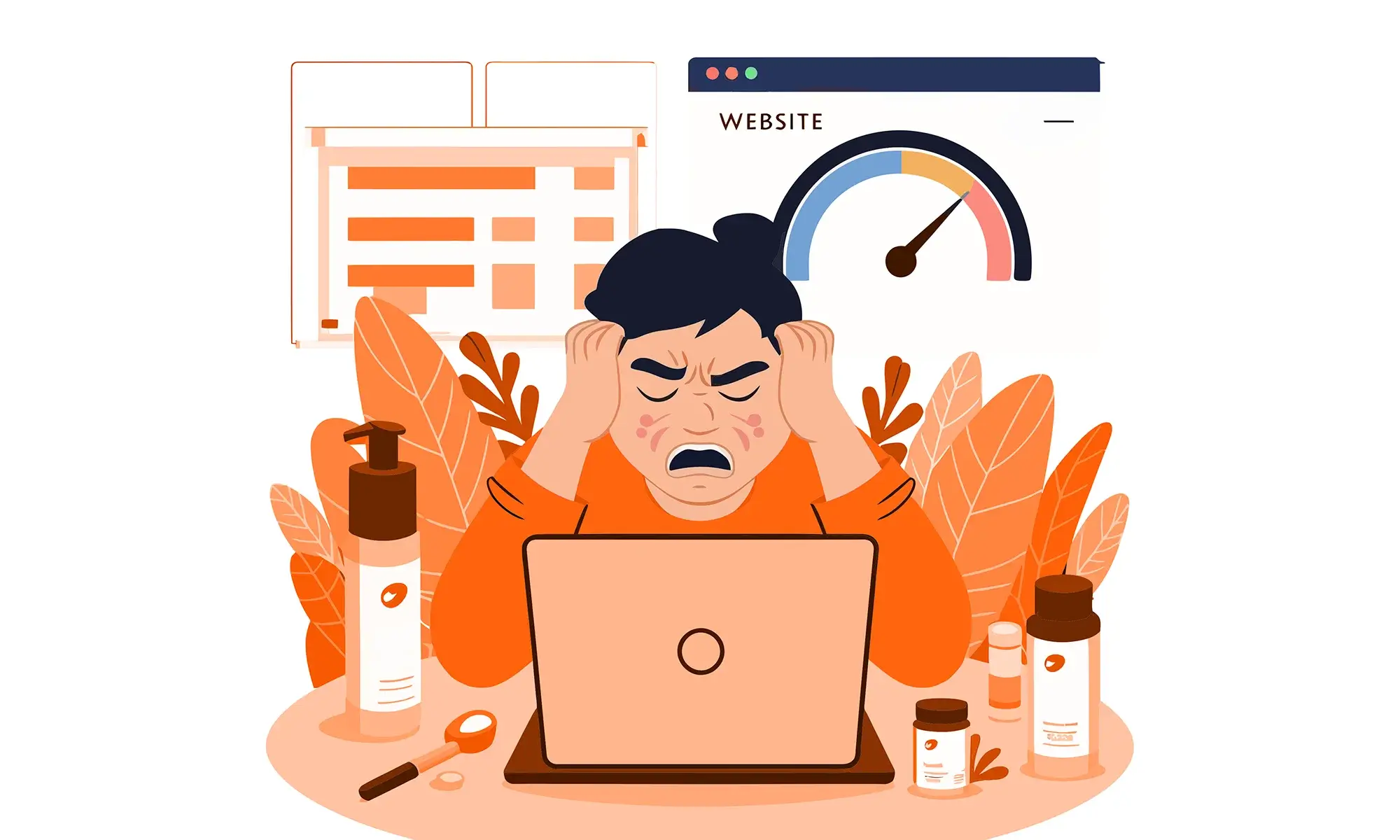Page Speed Optimisation (PSO) plays one of the most vital roles in shaping the user experience and SEO rankings of a website. Particularly in the skincare world, engaging visuals and comprehensive product information are integral to capturing and retaining user attention. This establishes the foundation for an in-depth examination of the unintended pitfalls associated with too much focus on page speed optimisation that many succumb to.
The Need for Speed
The modern digital landscape places a premium on swift, seamless user experiences. Within this sphere, the skincare industry finds itself in a unique position. Its reliance on rich visuals and detailed narratives to convey the transformative journey of skincare treatments and products often becomes a complex dance with page speed optimisation.
Industry standards lean towards shorter page load times, with a general benchmark being a load time of under 3 seconds, aligning with the expectation of 83% of online users who anticipate websites to load in three seconds or less. The allure of fast loading times isn’t without basis either, as data shows that the average page load speed among sites ranking on page one of Google is 1.65 seconds. These rapid load times can therefore significantly enhance user engagement and positively influence SEO rankings.
The mechanics of achieving this speed often come from common PSO techniques like image compression, code minification, and browser caching. Each of these techniques plays a crucial role in reducing the load time of a website. For instance, effective image compression reduces the file size of images, making them faster to load, while maintaining a satisfactory level of quality. Code minification removes unnecessary characters and whitespace from the code, making it more efficient. Browser caching stores copies of files locally, which speeds up subsequent page loads.
Kostas Alekoglu, an SEO expert Managing Director of Digital Aesthetics, captures the essence of this need for speed, stating, “In a digital age where every second counts, the appeal of a lightning-fast website is undeniable. However, the pursuit of a speedy website shouldn’t overshadow the essence of what makes skincare websites resonate with their audience, their visual attractiveness and the narrative of transformations on offer.”
His words serve as a fair reminder that while speed is important, the soul of skincare websites lies in their visual and narrative appeal.
Over-Optimising Page Speed: Where it Goes Wrong
The journey towards achieving a faster-loading website, however, is not without some serious challenges. Over-optimisation in a bid to achieve lightning-fast page speeds can lead to a significant degradation in image and video quality. The fine details and colours that define your products and services might be lost, leaving visuals flat and uninviting.
Results of this are often glaring, such as where the quest for speed has left a skincare website with blurry images and videos. There’s a tipping point where the compression of visual elements yields diminishing returns, as users begin to disengage with the content. Statistics underline this narrative, showing a notable drop-off in user engagement with a corresponding decline in visual quality. Pages that take only one or two seconds to load boast an average bounce rate of 9%, but this figure leaps to 38% for pages that take five seconds to load, so the balance between quality and speed becomes absolutely crucial.
This sharp rise in bounce rate illuminates the thin line that skincare websites tread in their quest for speed. To navigate these waters, here are some actionable steps to avoid over-optimisation:
- Utilise Adaptive Compression: Adaptive compression techniques can help maintain image quality while still reducing file size.
- Maintain Essential On-Page Elements: Retaining only the crucial on-page elements like customer reviews and detailed product descriptions can ensure that user engagement remains high. In a bid to achieve faster load times, such elements can be trimmed or entirely omitted as well.
- Implement a Content Delivery Network (CDN): A CDN can help distribute the load, saving bandwidth and speeding up access for your users.
- Regular Monitoring: Keeping a close eye on your website’s speed and user engagement metrics can provide insight into the impact of your optimisation efforts. This might highlight the key areas you need to strengthen your website in.
- Seek Professional Guidance: Consulting with an expert marketing agency with dedicated web development professionals can provide tailored advice and solutions, ensuring your practice has an engaging website.
Over-optimisation can also lead to technical glitches, such as broken links or failed redirects, further hampering the user experience.
Kostas Alekoglu paints a vivid picture of this trap, remarking, “Over-optimisation is like a skincare regimen that’s too aggressive. It strips away the essential elements that nourish the brand-user relationship, leaving an unattractive, unengaging user experience in its wake.”
Under-Optimising Page Speed: The Other Side of the Coin
On the flip side, under-optimising page speed has its repercussions too. A sluggish website can test the patience of users, leading to increased bounce rates. The adverse effects are apparent, with 40% of online users willing to abandon a website that takes longer than three seconds to load. This impatience also spills over to other sectors, such as the retail sphere, where nearly 70% of users assert that a retailer’s site speed influences their willingness to make a purchase.
The SEO rankings can take a significant hit from this, given that search engines like Google factor in page speed while determining the rankings. The user experience dwindles with slow loading times, as users might find it frustrating to wait for the content to load. These negative ripple effects extend to mobile users as well, who now form a significant portion of the digital audience.
A balanced approach to optimisation thus emerges as a necessity, catering to both the algorithmic requirements of search engines and the often-demanding expectations of users. Here are some steps to steer clear of under-optimisation:
- Employ Basic Optimisation Techniques: Implementing fundamental PSO techniques can significantly improve loading times without demanding excessive resources.
- Optimise for Mobile: With a significant portion of the digital audience accessing sites via mobile devices, ensuring your website is optimised for mobile is crucial.
- Regular Performance Audits: Conducting regular performance audits can help identify areas that require attention, keeping your website optimised and user-friendly.
- Turn to the Professionals: Much like over-optimising your website, a professional web design team will ensure that your site walks the fine line of perfect optimisation. We here at Digital Aesthetics pride ourselves on offering such optimisation, helping countless skincare clinics on their way to the best websites that suit their needs perfectly.
Striking the Right Balance
Navigating the tightrope between over and under-optimisation requires a nuanced approach. Adaptive image compression techniques become a cornerstone in this balanced approach, tailoring the compression level to the user’s device and network conditions. This ensures that visuals remain crisp and engaging without bogging down the page load times.
Lazy loading is another feather in the cap of balanced optimisation. It allows non-essential images and videos to load only when users scroll down to them, preserving both speed and visual richness. Content Delivery Networks (CDNs) serve as a key tool in this balanced approach, ensuring faster content delivery without compromising on quality. The geographical proximity of CDN servers to users reduces the time taken to load the content as well, offering a win-win situation.
Furthermore, regular monitoring and analysis of page speed and user engagement metrics are indispensable to making well-informed optimisation decisions. This data-driven approach allows for continuous refinement in the quest for balanced optimisation. Kostas Alekoglu’s words again resonate well here: “Striking the right balance in page speed optimisation is akin to formulating a skincare product, it requires a harmonious blend of elements to deliver a satisfying user experience without adverse reactions.”
As he says, this balanced approach mirrors the meticulous formulation of skincare products, orchestrating a harmonious blend of elements to deliver a captivating user experience without any adverse repercussions.
In Closing
This all brings to light the importance of a balanced approach to page speed optimisation. For skincare websites, where visuals and comprehensive information are the linchpins of user engagement, an extensive optimisation approach emerges as the path to fostering both speed and a rich user experience. Skincare practice owners and website developers are thus nudged to embrace a balanced optimisation strategy, one that finely melds speed with enriching user engagement, embodying that ideal win-win proposition we here at Digital Aesthetics offer.










